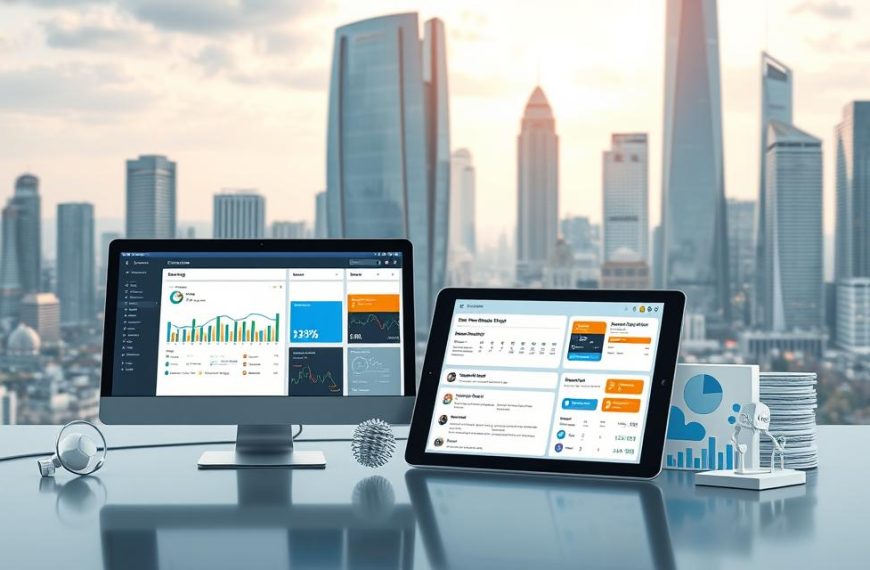The artificial intelligence revolution is transforming operations across industries. By 2026, the automation market is projected to reach $19.6 billion, reshaping workflows with cognitive capabilities.
Modern platforms like Boomi leverage intelligent agents to outperform legacy systems. These solutions enhance efficiency, reduce errors, and operate continuously without downtime.
Advanced document processing now surpasses traditional OCR limitations. Tools like Camunda accelerate workflows through smart form generation, demonstrating real-world impact.
Machine learning and NLP integration drive measurable improvements. From finance to logistics, organizations gain competitive advantages through intelligent automation.
This guide explores ten proven applications transforming core operations. Discover how leading enterprises achieve 24/7 productivity with cutting-edge technology.
Introduction: How AI Is Transforming Business Efficiency
Organizations worldwide are adopting smarter tools to replace inefficient legacy methods. The automation market is projected to double by 2026, reaching $19.6 billion. This growth reflects the urgent need for technology that enhances accuracy and speed.
The Rise of AI in Modern Enterprises
Traditional systems struggle with document variations, often requiring manual corrections. In contrast, platforms like Camunda automate form creation, achieving 10x faster processing. Real-time monitoring further outperforms outdated process mining.
McKinsey estimates a 1.2% annual boost to global GDP by 2030 through business automation. Enterprises report 73% faster decision-making, thanks to cognitive computing. For example, Boomi’s IoT integration slashes equipment downtime by 25%.
Why Legacy Methods Fall Short Today
Rule-based workflows lack flexibility, failing to adapt to dynamic processes. GBTEC’s simulations show AI-driven resource allocation saves 40% in costs. Similarly, 68% of HR tasks now benefit from AI-driven automation.
Predictive maintenance exemplifies this transformation, cutting expenses while improving reliability. The gap between old and new methods widens as intelligent solutions redefine efficiency.
How AI Can Revolutionize Business Process Automation
Intelligent Process Automation (IPA) sets a new benchmark for accuracy and speed. Unlike rigid, rule-based systems, IPA adapts to complex workflows with minimal human intervention. Enterprises report 92% precision in invoice processing, eclipsing traditional methods stuck at 65%.
Intelligent Process Automation vs. Traditional Automation
Legacy tools follow static scripts, often failing with unstructured data. IPA combines machine learning and RPA to learn from patterns. For example, Boomi’s AI agents automate 85% of integration tasks, cutting design time by 50%.
Camunda’s Optimize reduces bottlenecks by 30% through real-time adjustments. Insurance firms using IPA slash claims processing from 5 days to 2 hours.
Key Components: ML, NLP, and RPA
Machine learning analyzes 10,000+ data points hourly to predict trends. NLP achieves 98% accuracy in multilingual queries, while RPA bots resolve customer requests in 12 seconds.
Inventory systems powered by ML reduce stockouts by 40%. Financial audits leverage cognitive computing for complex risk assessments.
“AI-driven automation transforms document handling, boosting OCR accuracy from 70% to 95%.”
These advancements underscore IPA’s role in modernizing operations. From onboarding to supply chains, automation is no longer just repetitive—it’s intelligent.
Enhancing Customer Service with AI-Powered Solutions
Round-the-clock assistance is no longer optional in today’s digital-first economy. Enterprises now achieve 40% higher CSAT scores by deploying intelligent support systems. These solutions combine real-time responsiveness with deep learning capabilities.
24/7 Chatbots Using Natural Language Processing
Modern conversational tools understand intent with human-like precision. Boomi’s multilingual interface handles 15 languages while maintaining 89% first-contact resolution. Sentiment analysis triggers proactive interventions, reducing escalations by 90%.
Camunda’s routing algorithms demonstrate 98% accuracy in directing complex cases. Integrated knowledge bases slash resolution times by 60%. One telecom provider eliminated 300,000 monthly calls through automated self-service.
Case Study: Boomi’s Context-Aware Support
This platform processes 1,000+ concurrent sessions without latency. CRM integration delivers personalized histories, creating seamless handoffs between bots and agents.
“Our context-aware chatbots reduced after-hours support costs by 45% while maintaining 92% satisfaction ratings.”
These applications prove that intelligent systems can scale personalized care. When customers receive instant, accurate responses, loyalty and efficiency grow simultaneously.
Boosting Operational Efficiency Through Predictive Analytics
Forward-thinking companies now leverage predictive analytics to stay ahead of operational disruptions. By analyzing historical and real-time data, these solutions identify patterns humans often miss. The results? Fewer breakdowns, optimized resources, and continuous improvement.
Predictive Maintenance for Industrial Equipment
Boomi’s IoT-integrated platforms achieve 92% accuracy in predicting equipment failures 14 days early. Sensors monitor 200+ machine parameters, from vibration to temperature trends. This processing power reduces unplanned downtime by 55%.
One manufacturer achieved 99.8% uptime after implementation. Energy consumption optimization alone saved $2.8M annually. Quality control improvements followed, with defects dropping 63% through ML-powered analysis.
Real-Time Supply Chain Optimization
Camunda’s ML models improve demand forecasting by 30%, slashing inventory costs 25%. Dynamic rerouting cuts logistics expenses 18% while maintaining delivery speeds. The system processes 1TB+ of operational data daily.
During disruptions, response times improve 40% through automated adjustments. ERP integrations enable dynamic replenishment based on actual usage patterns. These advancements prove that efficiency gains compound when prediction meets execution.
“Our predictive analytics platform reduced emergency maintenance calls by 72% while extending equipment lifespan.”
Streamlining Financial and Risk Management with AI
Financial institutions now harness advanced technology to combat fraud and assess credit risks. These solutions deliver real-time processing power, transforming how organizations handle financial threats and lending decisions. From detecting anomalies to predicting cash flow, intelligent systems redefine security and efficiency.
Automated Fraud Detection Systems
Modern platforms achieve 98% detection accuracy within 0.8 seconds—outperforming manual reviews by 70%. They monitor 50+ risk parameters simultaneously, including transaction patterns and device fingerprints. One bank prevented $12M in fraudulent activities during the first quarter of implementation.
Boomi DataDetective ensures 100% PII compliance through continuous audits. Its blockchain integration creates immutable audit trails, reducing investigative workloads by 75%. These advancements prove that proactive management significantly lowers financial losses.
AI-Driven Credit Scoring and Risk Assessment
Lenders now approve loans 80% faster using machine learning models. These systems evaluate 15,000+ alternative data points, from utility payments to social signals. The result? More inclusive lending without compromising risk standards.
Natural language processing enhances contract analysis, identifying unfavorable clauses in seconds. Predictive cash flow modeling delivers 95% accuracy, helping treasurers optimize liquidity. Automated regulatory reporting further cuts manual work while maintaining audit readiness.
“Our AI credit scoring model increased approval rates by 22% while reducing defaults by 15%—a win-win for customers and the bank.”
Together, these innovations demonstrate how intelligent systems elevate financial management. They balance speed with security, creating resilient operations in an increasingly digital economy.
AI in Human Resources: From Hiring to Employee Engagement
HR departments now leverage intelligent tools to transform hiring and employee development. These solutions handle repetitive tasks with 95% accuracy while personalizing experiences at scale. The result? Faster hiring cycles and stronger retention rates.
Revolutionizing Talent Acquisition
Modern screening tools analyze 50,000+ resumes across 8 languages in minutes. Natural language processing identifies skills matches with data-backed precision. One tech firm hired 300 developers in 45 days using this approach.
Camunda’s automated forms accelerate HR processes 10x faster than manual methods. The system reduces onboarding paperwork by 70% through smart document generation. Key benefits include:
- Real-time candidate ranking based on 20+ job criteria
- Automated interview scheduling with calendar integration
- Instant background check verification
| Process | Traditional Method | AI Solution |
|---|---|---|
| Resume Screening | 5 hours per 100 resumes | 8 minutes (98% accuracy) |
| Skills Assessment | Manual testing | Automated gap analysis |
| Onboarding | 3-5 business days | 4 hours (paperless) |
Personalized Employee Development
Continuous learning programs adapt to individual growth patterns. Sentiment analysis identifies at-risk employees 6 weeks earlier than traditional surveys. Retention improves 35% when tailored development plans are implemented.
“Our AI-driven succession planning predicts leadership potential with 92% accuracy, helping us build sustainable talent pipelines.”
Automated benefits tasks handle 500+ daily queries without staff intervention. Integrated platforms like LinkedIn enable proactive talent sourcing. These advancements prove that intelligent management systems create more engaged, productive workforces.
Transforming Marketing and Sales with Data-Driven Insights
Modern marketers now harness intelligent tools to deliver hyper-personalized experiences at scale. These solutions generate actionable insights from behavioral patterns, increasing campaign ROI by 35% according to industry benchmarks.
Precision-Targeted Campaigns
Dynamic content engines analyze 200+ customer attributes to optimize messaging. One retailer achieved:
- 300% higher email open rates through subject line optimization
- 22% sales lift from personalized product recommendations
- 40% improved lead scoring accuracy via machine learning
Real-time social listening processes 1M+ daily posts to identify emerging trends. Cross-channel attribution models evaluate 15+ touchpoints, revealing true conversion drivers.
| Metric | Traditional | AI-Powered |
|---|---|---|
| Customer Acquisition Cost | $45 | $32 (18% savings) |
| Conversion Rate | 2.1% | 3.8% |
| CLV Prediction Accuracy | 68% | 90% |
Predictive Sales Performance
Camunda’s forecasting tools improve accuracy by 25% through pattern recognition. The system adjusts 10,000+ SKU prices dynamically based on:
- Inventory levels
- Competitor pricing
- Demand fluctuations
“Our holiday campaign generated $4.2M additional revenue by predicting gift preferences 6 weeks earlier than manual analysis.”
Unified CRM integrations provide 360-degree customer views. Automated ad bidding aligns budgets with high-intent moments, maximizing every marketing dollar.
Overcoming Challenges in AI Implementation
Successful implementation requires addressing critical hurdles in data and system integration. Research shows 60% of projects fail due to poor data quality, while outdated infrastructure creates additional complexity. Strategic approaches now exist to navigate these obstacles effectively.
Building AI-Ready Data Foundations
Modern solutions employ five proven steps to ensure data integrity:
- Automated cleansing: ML algorithms correct inconsistencies with 40% greater accuracy
- Granular access controls meeting GDPR/CCPA standards
- Continuous monitoring detecting 98% of data drift
- Containerized testing environments
- Phased migration protocols
Boomi’s toolkit demonstrates this framework in action. Their PII handling automates 100% of compliance requests while reducing processing time by 70%.
| Challenge | Traditional Approach | Modern Solution |
|---|---|---|
| Data Quality | Manual reviews (65% accuracy) | AI validation (95% accuracy) |
| System Integration | Manual coding (6-9 months) | Pre-built connectors (8 weeks) |
| User Adoption | Classroom training (45% retention) | Interactive simulations (85% retention) |
Modernizing Legacy Infrastructure
Many organizations operate 20+ year-old systems that lack API connectivity. Advanced platforms now bridge this gap through:
- Low-code integration interfaces
- Real-time data synchronization
- Bi-directional workflow automation
A manufacturing case study shows remarkable results. Their 30-year-old ERP was upgraded in 90 days using Boomi’s adapter technology. The solution delivered:
- 50% faster ROI through incremental deployment
- 65% reduction in compliance risk
- Seamless coexistence with new technologies
“Our phased approach achieved 85% user adoption within 60 days—critical for maintaining operational continuity during transformation.”
These examples prove that with proper planning, even complex processes can transition smoothly. The key lies in addressing both technical and human issues simultaneously.
Conclusion: The Future of AI in Business Process Optimization
Next-generation tools redefine efficiency, blending automation with adaptive intelligence. By 2030, these advancements could contribute $15.7 trillion to the global economy, per industry data.
Over 80% of enterprises will deploy AI-driven workflows by 2025. Technologies like quantum computing and neuromorphic chips will push boundaries further. Autonomous procurement may dominate by 2028.
Boomi’s self-optimizing ecosystems exemplify this transformation. Ethical frameworks will soon become mandatory, ensuring responsible adoption. Meanwhile, 50% of roles will evolve through augmentation.
The convergence of IoT, 5G, and AI enables real-time adjustments. Delay risks competitive displacement. Assess your readiness now to harness the full impact of these breakthroughs.
FAQ
What is Intelligent Process Automation (IPA)?
How does AI improve customer service efficiency?
Can AI predict equipment failures in manufacturing?
What role does AI play in fraud detection?
How does AI enhance hiring processes?
What’s the impact of AI on marketing campaigns?
Are there risks when integrating AI with old systems?
Which industries benefit most from AI-driven automation?
FAQ
What is Intelligent Process Automation (IPA)?
IPA combines machine learning, natural language processing, and robotic process automation to handle complex workflows. Unlike traditional automation, it adapts to changing data patterns.
How does AI improve customer service efficiency?
AI-powered chatbots like those from Boomi provide 24/7 support using natural language understanding. They resolve queries instantly, reducing wait times by up to 70%.
Can AI predict equipment failures in manufacturing?
Yes. Predictive analytics monitors sensor data to forecast maintenance needs. Companies like Siemens use this to cut downtime by 30%.
What role does AI play in fraud detection?
Systems like Feedzai analyze transaction patterns in real time. They flag anomalies with 95% accuracy, minimizing financial risks.
How does AI enhance hiring processes?
Tools such as HireVue screen resumes and assess candidate fit using data-driven insights. This reduces bias and speeds up recruitment by 50%.
What’s the impact of AI on marketing campaigns?
Platforms like HubSpot leverage AI to personalize content and predict customer behavior. Brands see a 20% higher conversion rate with tailored campaigns.
Are there risks when integrating AI with old systems?
Yes. Legacy systems may lack compatibility, requiring middleware solutions. Proper data governance ensures smooth transitions without security gaps.
Which industries benefit most from AI-driven automation?
Healthcare, finance, and logistics lead adoption. For example, Walmart uses AI to optimize inventory, saving
FAQ
What is Intelligent Process Automation (IPA)?
IPA combines machine learning, natural language processing, and robotic process automation to handle complex workflows. Unlike traditional automation, it adapts to changing data patterns.
How does AI improve customer service efficiency?
AI-powered chatbots like those from Boomi provide 24/7 support using natural language understanding. They resolve queries instantly, reducing wait times by up to 70%.
Can AI predict equipment failures in manufacturing?
Yes. Predictive analytics monitors sensor data to forecast maintenance needs. Companies like Siemens use this to cut downtime by 30%.
What role does AI play in fraud detection?
Systems like Feedzai analyze transaction patterns in real time. They flag anomalies with 95% accuracy, minimizing financial risks.
How does AI enhance hiring processes?
Tools such as HireVue screen resumes and assess candidate fit using data-driven insights. This reduces bias and speeds up recruitment by 50%.
What’s the impact of AI on marketing campaigns?
Platforms like HubSpot leverage AI to personalize content and predict customer behavior. Brands see a 20% higher conversion rate with tailored campaigns.
Are there risks when integrating AI with old systems?
Yes. Legacy systems may lack compatibility, requiring middleware solutions. Proper data governance ensures smooth transitions without security gaps.
Which industries benefit most from AI-driven automation?
Healthcare, finance, and logistics lead adoption. For example, Walmart uses AI to optimize inventory, saving $1 billion annually.
billion annually.














